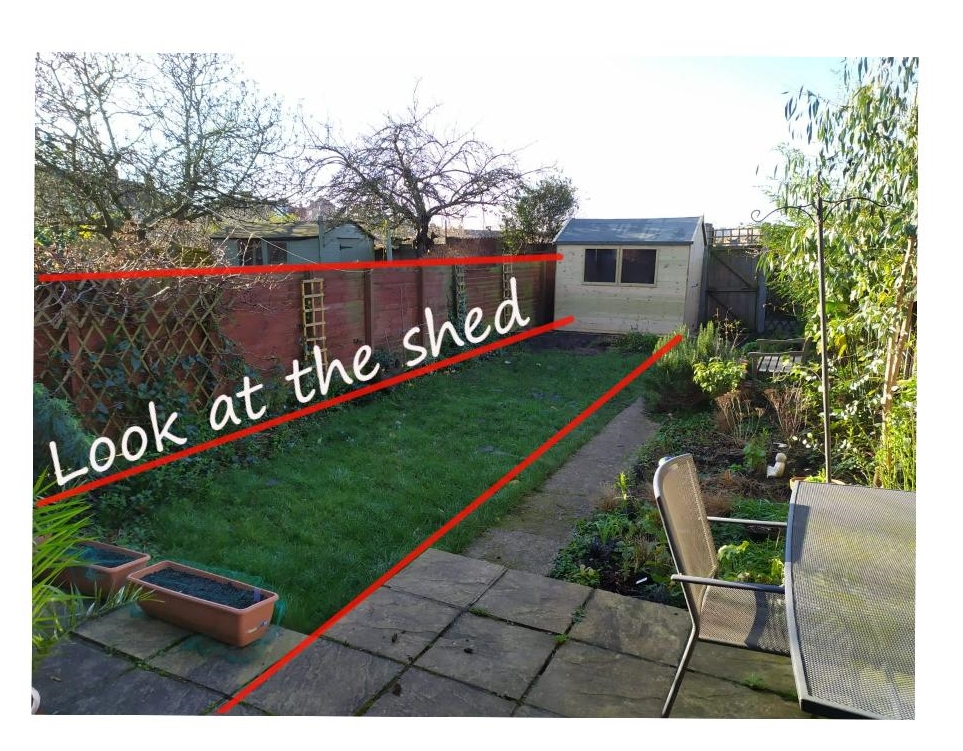
Gardens are wonderful places to be, but often the garden just does not deliver what it should. So how does a non-expert create a garden that is practical, affordable and beautiful, when they have never designed a garden before. Follow these 7 simple rules of garden design that help you make the right changes to your garden.
Now before we start, all the advice offered here at PlantPlots, assumes you, the reader would love to have a more gorgeous garden; if you knew what to do. That you will do the work yourself and that the garden has to be created without spending a fortune! So with that in mind here are our 7 simple rules of garden design.
For more design help and advice watch our design videos
7 simple rules of garden design:
- Plan the garden around the best place to sit
- Don’t make borders; create shapes instead
- Avoid following the fence line
- Never be able to see the whole length of a fence
- Paths shouldn’t only lead to the shed
- 80% of the plants should offer more than just a pretty flower
- Plan the planting from eye-level down not bottom up
Rule 1: Plan the garden around the best place to sit.
This may seem blindingly obvious, but I see so many examples of designs created to impress rather than to use. We all have our favourite spots in the garden, be it for a morning coffee or it has hit ‘gin o’clock’ and the sun always shine in a certain spot for you to enjoy at the end of the day. These are the areas you need to start the design from.
The sun will not shine on a seating area just because the design layout looked better with the patio in a certain location. It’s a question of working with your weather not imposing a design that looks good.
So, if the favourite part of the garden in not next to the house, the design has to get you there. You need a route to walk down, that gets you to your favourite spot. Then you need a place to sit that is comfortable, and usable for as much of the year as possible.
Once you are there, sitting down, the garden has to do something – it has to make you feel relaxed, so you can enjoy that moment. There has to be something worth looking at other than fences, walls. or sheds; the garden needs a ‘look at me instead’ border.
Our aim is to make gardening easier, so we have written these garden design guides to download – for free!
Rule 2: Don’t make borders; create shapes instead
The most common design mistake made by gardeners is when creating a border. The border is created in a certain shape, these are often long and thin, or wavy edged. But the border shape is what is decided on first.. And it’s this that is the problem.

In any normal suburban garden two shapes dominate; the overall shape of the garden and the shape of the lawn. So one of the most important rules of garden design is that if borders are created first, the lawn has to fit the shape of the border. The shape of the lawn then gets warped by the borders; and this weird wobble of a shape then dominates your view.
Plants are really good at hiding odd shapes, so start with the lawn and make that shape an even circle, sweep, square rectangle or diamond. It doesn’t matter if part of that shape is cut off, it will still look like a circle or square. The borders become the bits left over. Plant these and the odd shape of the border disappears, leaving you with the nice sweep of the lawn!
Type in your design query or contact us
Rule 3: Avoid following the fence line
Humans notice two things the most, movement (an evolutionary throwback that helped save early humans from being stalked by predators) and lines. If there is a visual line our eyes naturally follow it to the end.
And gardens have lots of lines, most noticeably the lines of the garden boundary. These can be fences, walls or hedges. If the line of the garden border mirrors the line of the fences; all the design is doing is say ‘look at the fences’! It makes the boundary the most important feature, the fence more visually dominant. The result is the garden feel smaller because as the user of the garden the design makes you fully aware of where the edges are.


Rule 4: Never be able to see the whole length of a fence
This follows on from the above rule. Fences walls or boundaries are never the most attractive feature in an garden but are visually dominant. This is for two reasons, firstly the lines these create but secondly as there is just so much of them to see, and all of it is at eye-level. You simply can’t not notice them.
The plant of action here then is to reduce the amount of the boundary you see as a whole; break it down into smaller chunks. If some plants or object are also taller than the fence, this too helps break up the linear dominance.
You notice the fence less because you notice other things instead.


Rule 5: Paths shouldn’t only lead to the shed
There seems to be a train of thought that states a path is always needed to the garden shed. Indeed you do IF the garden shed is used frequently, but how often is the shed acessed? Once a week, and hardly in the winter as the lawn doesn’t get mown? Once the shed is reached, how often is the path walked on back to the house, often the mower is used, so it was only the walk to the shed when the path actually got used – which might last a few seconds!
The question needs to be asked as to why the path is needed!
In a small garden the most well used route in the garden needs the path. The footfall this route receives will cause wear and tear, so a durable path makes sense. If that also happens to be the shed, fine. If not, adding a path to the shed creates a design issue.
It makes you notice the shed even more – and as most sheds aren’t terribly attractive, your enjoyment of the garden is reduced.
Visit our Designs Shop
Rule 6: 80% of the plants should offer more than just a pretty flower
We all love gorgeous flowers, but the flower only lasts for a few weeks of the year. The impact the plant has in flower is lovely, but what happens then? The average size of a gardens is shrinking, consequently the plants in the garden have to work harder to impress.
A simple rule of thumb to follow when choosing plants is this:
Aside from a pretty flower what else does this plant do?
This could be scented leaves, or the foliage changes colour with the season. It might be nice to run your fingers through or is dances in a breeze. The point is the plant needs to provide more than just flowers.
Rule 7: Plan the planting from eye-level down not bottom up
Do you walk along staring down at your feet and the ground? No of course we don’t; we (should) stare straight ahead. When planning the planting, this is the starting point.
When you sit in your favourite part of the garden you need plants that look great at right in front of you, not at your feet.

If you stare out of the kitchen window, there should be interesting plants at eye level to look at.
If borders are planted from the bottom up all the space gets filled with low lying plants, leaving the only options for hiding the fences (or not) being a climber.
Choose a really gorgeous plant and pop it in a few places in the garden, this will help you look around the garden plants to find it and it will make the planting seem better coordinated. All of which help make your garden better!
So there you have it, 7 simple rules of garden design made a bit simpler.
But just in case you are still a bit stuck… why not visit our design shop for planting ideas for the garden or look at our amazing book ‘I Want to Like my Garden‘. Or you can email me: rachel@plantplots.com or check out some of the garden designs we have created for your customers.
Now clearly we could write a book on garden design that will help you plan your gardens better – and amazingly there IS a book to help you
I Want to Like my Garden by Rachel McCartain available at Amazon and other online bookstores in eBook and Paperback
















